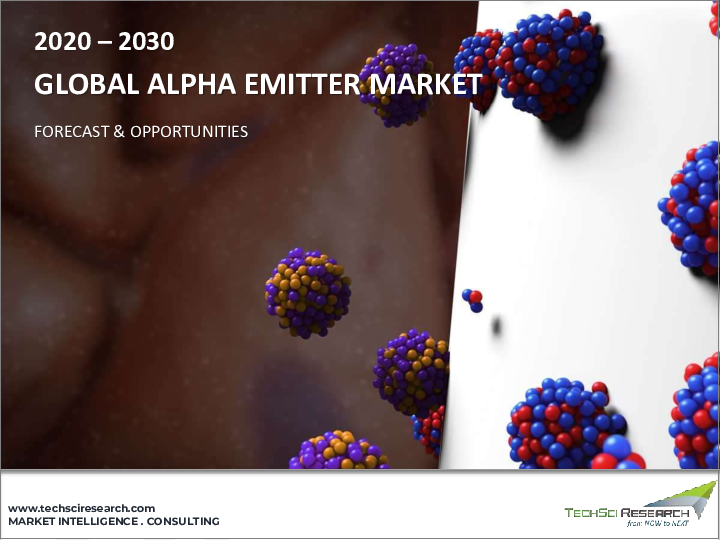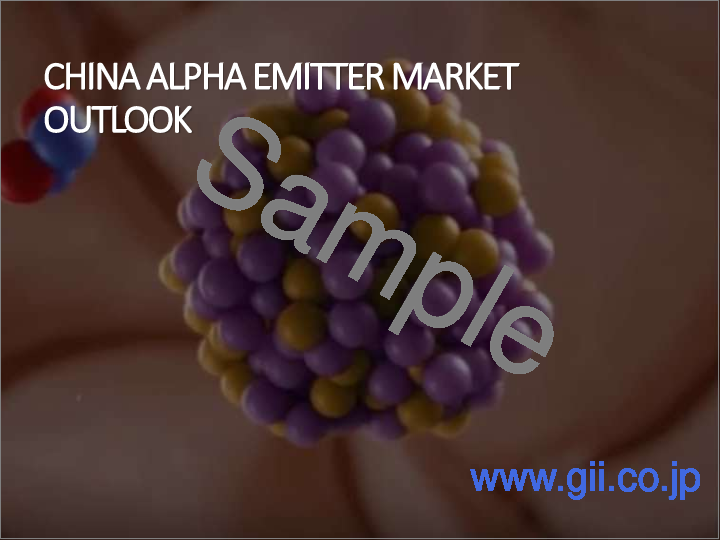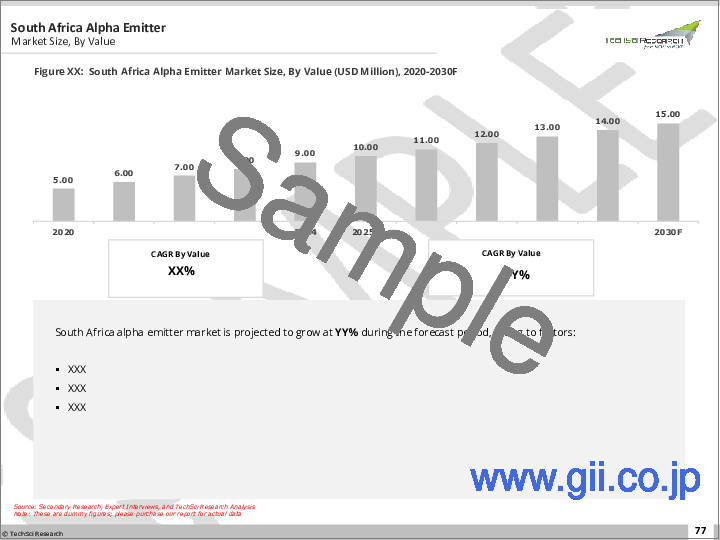|
|
市場調査レポート
商品コード
1692179
アルファエミッター市場- 世界の産業規模、シェア、動向、機会、予測放射性核種タイプ別(アスタチン、ラジウム、アクチニウム、鉛、ビスマス、その他)、医療用途別、地域別、競合市場別、2020-2030年Alpha Emitter Market - Global Industry Size, Share, Trends, Opportunity, & Forecast Segmented By Type of Radionuclide (Astatine, Radium, Actinium, Lead, Bismuth, Other), By Medical Application, By Region & Competition, 2020-2030F |
||||||
カスタマイズ可能
|
|||||||
| アルファエミッター市場- 世界の産業規模、シェア、動向、機会、予測放射性核種タイプ別(アスタチン、ラジウム、アクチニウム、鉛、ビスマス、その他)、医療用途別、地域別、競合市場別、2020-2030年 |
|
出版日: 2025年03月24日
発行: TechSci Research
ページ情報: 英文 180 Pages
納期: 2~3営業日
|
全表示
- 概要
- 目次
アルファエミッターの世界市場は2024年に4億6,610万米ドルとなり、2030年までのCAGRは9.80%で、予測期間中に力強い成長が予測されています。
アルファエミッターの世界市場は、核医学と放射線治療という広範な分野の中の専門分野です。アルファ粒子を放出する放射性同位元素であるアルファ放出核種の生産、流通、応用を中心に展開します。その背景には、疾病の蔓延、がん患者の増加、高齢化人口の増加などがあります。例えば、国際がん研究機関(IARC)は、2040年までに世界のがん患者数は2,750万人に増加し、がん関連死亡者数は1,630万人に達すると予測しています。さらに、2022年8月にRadiation誌に掲載された論文では、転移性去勢抵抗性前立腺がんに対するラジウム223療法の最適な使用法を探る日本の近大科学者の研究が紹介されました。この研究では、Ra-223の早期投与が全生存期間(OS)を有意に改善することが示され、新規ホルモン療法や抗がん剤治療の前にRa-223を使用することの潜在的な利点が強調されました。アルファ線放出核種は、そのユニークな特性から医療、産業、エネルギー分野で脚光を浴びており、市場は顕著な成長と革新を経験しています。陽子2個と中性子2個からなるアルファ粒子が放出されるためです。これらの粒子は高電荷を帯びており、組織内での飛程が短いため、局所治療に効果的です。アルファ線は強力で、近くの健康な組織を温存しながら正確にがん細胞にダメージを与え、破壊することができます。
| 市場概要 | |
|---|---|
| 予測期間 | 2026-2030 |
| 市場規模:2024年 | 4億6,610万米ドル |
| 市場規模:2030年 | 8億1,037万米ドル |
| CAGR:2025年~2030年 | 9.80% |
| 急成長セグメント | 卵巣がん |
| 最大市場 | 北米 |
市場促進要因
核医学に対する需要の高まり
主な市場課題
規制上のハードル
主要市場動向
標的α粒子治療の進歩:
目次
第1章 概要
第2章 調査手法
第3章 エグゼクティブサマリー
第4章 顧客の声
第5章 世界のアルファエミッター市場展望
- 市場規模・予測
- 金額別
- 市場シェア・予測
- 放射性核種の種類別(アスタチン(At-211)、ラジウム(Ra-223)、アクチニウム(Ac-225)、鉛(Pb-212)、ビスマス(Bi-212)、その他)
- 医療用途別(前立腺がん、骨転移、卵巣がん、膵臓がん、内分泌腫瘍、その他)
- 地域別
- 企業別(2024)
- 市場マップ
第6章 北米のアルファエミッター市場展望
- 市場規模・予測
- 市場シェア・予測
- 北米:国別分析
- 米国
- カナダ
- メキシコ
第7章 欧州のアルファエミッター市場展望
- 市場規模・予測
- 市場シェア・予測
- 欧州:国別分析
- ドイツ
- 英国
- イタリア
- フランス
- スペイン
第8章 アジア太平洋地域のアルファエミッター市場展望
- 市場規模・予測
- 市場シェア・予測
- アジア太平洋地域:国別分析
- 中国
- インド
- 日本
- 韓国
- オーストラリア
第9章 南米のアルファエミッター市場展望
- 市場規模・予測
- 市場シェア・予測
- 南米:国別分析
- ブラジル
- アルゼンチン
- コロンビア
第10章 中東・アフリカのアルファエミッター市場展望
- 市場規模・予測
- 市場シェア・予測
- 中東・アフリカ:国別分析
- 南アフリカ
- サウジアラビア
- アラブ首長国連邦
第11章 市場力学
- 促進要因
第11章 2つの課題
第12章 市場動向と発展
- 最近の動向
- 製品上市
- 合併と買収
第13章 世界のアルファエミッター市場:SWOT分析
第14章 競合情勢
- Actinium Pharmaceutical Inc.
- Alpha Tau Medical Ltd
- Bayer AG
- Fusion Pharmaceuticals
- IBA Radiopharma Solutions
- RadioMedix Inc.
- Telix Pharmaceuticals Ltd
- Novartis International AG
- Isotopen Technologien Munchen AG(ITM)
- NorthStar Medical Radioisotopes
第15章 戦略的提言
第16章 調査会社について・免責事項
Global Alpha Emitter Market Was valued at USD 466.10 million in 2024 and is anticipated to project robust growth in the forecast period with a CAGR of 9.80% through 2030. The Global Alpha Emitter Market is a specialized sector within the broader field of nuclear medicine and radiation therapy. It revolves around the production, distribution, and application of alpha-emitting radionuclides, which are radioactive isotopes emitting alpha particles. This is ascribed due to the growing disease prevalence, growing cancer cases, rising aging population, etc. For instance, the International Agency for Research on Cancer (IARC) projects that by 2040, the global cancer burden will rise to 27.5 million new cases and 16.3 million cancer-related deaths, largely due to population growth and aging. Additionally, an August 2022 article in the Radiation journal featured research by a Kindai University scientist in Japan exploring the optimal use of Radium-223 therapy for Metastatic Castration-Resistant Prostate Cancer. The study indicated that early administration of Ra-223 significantly improved overall survival (OS), highlighting potential advantages of using Ra-223 before novel hormonal or anticancer treatments. Alpha emitters have gained prominence in medical, industrial, and energy sectors due to their unique characteristics, and the market is experiencing notable growth and innovation. Due to the release of alpha particles, which consist of two protons and two neutrons. These particles are highly charged and have a short range in tissue, making them effective for localized therapy. Alpha radiation is potent, capable of damaging and destroying cancer cells with precision while sparing nearby healthy tissue.
| Market Overview | |
|---|---|
| Forecast Period | 2026-2030 |
| Market Size 2024 | USD 466.10 Million |
| Market Size 2030 | USD 810.37 Million |
| CAGR 2025-2030 | 9.80% |
| Fastest Growing Segment | Ovarian Cancer |
| Largest Market | North America |
Key Market Drivers
Growing Demand for Nuclear Medicine
One of the primary drivers of the Global Alpha Emitter Market is the increasing demand for nuclear medicine. Advances in medical science have revealed the efficacy of alpha emitters in targeted cancer therapy. Alpha particles are highly effective at killing cancer cells, making them a vital component of radiopharmaceuticals used in cancer treatment. The shift towards precision medicine is another key reason for the growing demand. Medical professionals are increasingly tailoring treatments to individual patients, and alpha emitters offer a precise way to target cancerous cells while minimizing damage to healthy tissue. The global rise in cancer cases is a significant driver. As cancer incidence continues to increase, the demand for effective treatment options also grows. Alpha emitters provide a promising solution for certain types of cancers that are challenging to treat through conventional methods. Ongoing clinical trials and research efforts are further fueling demand. Pharmaceutical companies and research institutions are investing heavily in the development of new alpha-emitting radiopharmaceuticals, expanding the range of treatable conditions. Increasing patient awareness and advocacy groups' efforts have contributed to the demand for nuclear medicine. Patients and their families are seeking out cutting-edge treatments, and alpha emitter-based therapies are becoming more accessible and sought after.
Key Market Challenges
Regulatory Hurdles
Regulatory hurdles, such as stringent licensing and safety regulations, can significantly impede the growth of the Global Alpha Emitter Market. Governments and regulatory bodies closely monitor the use and transport of radioactive materials, including alpha emitters, due to safety concerns. This leads to lengthy approval processes and strict compliance requirements. The highly radioactive nature of alpha emitters necessitates rigorous oversight to prevent accidents and ensure public safety. However, the complexity and stringency of regulatory processes can slow down the development and commercialization of alpha-emitting products. Companies may face delays and increased costs in navigating the regulatory landscape, hindering market growth.
Key Market Trends
Advancements in Targeted Alpha-Particle Therapy:
A significant trend in the Global Alpha Emitter Market is the continuous advancements in targeted alpha-particle therapy. This therapy involves the use of alpha-emitting radiopharmaceuticals to precisely target and destroy cancer cells while sparing healthy tissue. Recent research and development efforts have led to the creation of novel alpha-emitting compounds that are more effective and have reduced side effects. This trend is driven by the increasing focus on personalized medicine in oncology. Healthcare providers and pharmaceutical companies are investing in research to develop alpha emitters that can be tailored to a patient's specific cancer type and genetic profile. As a result, targeted alpha-particle therapy is gaining prominence as a promising and minimally invasive treatment option for various cancers, including prostate, bone, and pancreatic cancer.
Key Market Players
- Actinium Pharmaceutical Inc.
- Alpha Tau Medical Ltd
- Bayer AG
- Fusion Pharmaceuticals
- IBA Radiopharma Solutions
- RadioMedix Inc.
- Telix Pharmaceuticals Ltd
- Novartis International AG
- Isotopen Technologien Munchen AG(ITM)
- NorthStar Medical Radioisotopes
Report Scope:
In this report, the Global Alpha Emitter Market has been segmented into the following categories, in addition to the industry trends which have also been detailed below:
Alpha Emitter Market, By Type of Radionuclide:
- Astatine (At-211)
- Radium (Ra-223)
- Actinium (Ac-225)
- Lead (Pb-212)
- Bismuth (Bi-212)
- Other
Alpha Emitter Market, By Medical Application:
- Prostate Cancer
- Bone Metastasis
- Ovarian Cancer
- Pancreatic Cancer
- Endocrine Tumors
- Other
Alpha Emitter Market, By Region:
- North America
- United States
- Canada
- Mexico
- Europe
- France
- United Kingdom
- Italy
- Germany
- Spain
- Asia-Pacific
- China
- India
- Japan
- Australia
- South Korea
- South America
- Brazil
- Argentina
- Colombia
- Middle East & Africa
- South Africa
- Saudi Arabia
- UAE
Competitive Landscape
Company Profiles: Detailed analysis of the major companies present in the Global Alpha Emitter Market.
Available Customizations:
Global Alpha Emitter market report with the given market data, TechSci Research offers customizations according to a company's specific needs. The following customization options are available for the report:
Company Information
- Detailed analysis and profiling of additional market players (up to five).
Table of Contents
1. Product Overview
- 1.1. Market Definition
- 1.2. Scope of the Market
- 1.2.1. Markets Covered
- 1.2.2. Years Considered for Study
- 1.2.3. Key Market Segmentations
2. Research Methodology
- 2.1. Objective of the Study
- 2.2. Baseline Methodology
- 2.3. Key Industry Partners
- 2.4. Major Association and Secondary Sources
- 2.5. Forecasting Methodology
- 2.6. Data Triangulation & Validation
- 2.7. Assumptions and Limitations
3. Executive Summary
- 3.1. Overview of the Market
- 3.2. Overview of Key Market Segmentations
- 3.3. Overview of Key Market Players
- 3.4. Overview of Key Regions/Countries
- 3.5. Overview of Market Drivers, Challenges, Trends
4. Voice of Customer
5. Global Alpha Emitter Market Outlook
- 5.1. Market Size & Forecast
- 5.1.1. By Value
- 5.2. Market Share & Forecast
- 5.2.1. By Type of Radionuclide (Astatine (At-211), Radium (Ra-223), Actinium (Ac-225), Lead (Pb-212), Bismuth (Bi-212), Other)
- 5.2.2. By Medical Application (Prostate Cancer, Bone Metastasis, Ovarian Cancer, Pancreatic Cancer, Endocrine Tumors, Other)
- 5.2.3. By Region
- 5.2.4. By Company (2024)
- 5.3. Market Map
6. North America Alpha Emitter Market Outlook
- 6.1. Market Size & Forecast
- 6.1.1. By Value
- 6.2. Market Share & Forecast
- 6.2.1. By Type of Radionuclide
- 6.2.2. By Medical Application
- 6.2.3. By Country
- 6.3. North America: Country Analysis
- 6.3.1. United States Alpha Emitter Market Outlook
- 6.3.1.1. Market Size & Forecast
- 6.3.1.1.1. By Value
- 6.3.1.2. Market Share & Forecast
- 6.3.1.2.1. By Type of Radionuclide
- 6.3.1.2.2. By Medical Application
- 6.3.1.1. Market Size & Forecast
- 6.3.2. Canada Alpha Emitter Market Outlook
- 6.3.2.1. Market Size & Forecast
- 6.3.2.1.1. By Value
- 6.3.2.2. Market Share & Forecast
- 6.3.2.2.1. By Type of Radionuclide
- 6.3.2.2.2. By Medical Application
- 6.3.2.1. Market Size & Forecast
- 6.3.3. Mexico Alpha Emitter Market Outlook
- 6.3.3.1. Market Size & Forecast
- 6.3.3.1.1. By Value
- 6.3.3.2. Market Share & Forecast
- 6.3.3.2.1. By Type of Radionuclide
- 6.3.3.2.2. By Medical Application
- 6.3.3.1. Market Size & Forecast
- 6.3.1. United States Alpha Emitter Market Outlook
7. Europe Alpha Emitter Market Outlook
- 7.1. Market Size & Forecast
- 7.1.1. By Value
- 7.2. Market Share & Forecast
- 7.2.1. By Type of Radionuclide
- 7.2.2. By Medical Application
- 7.2.3. By Country
- 7.3. Europe: Country Analysis
- 7.3.1. Germany Alpha Emitter Market Outlook
- 7.3.1.1. Market Size & Forecast
- 7.3.1.1.1. By Value
- 7.3.1.2. Market Share & Forecast
- 7.3.1.2.1. By Type of Radionuclide
- 7.3.1.2.2. By Medical Application
- 7.3.1.1. Market Size & Forecast
- 7.3.2. United Kingdom Alpha Emitter Market Outlook
- 7.3.2.1. Market Size & Forecast
- 7.3.2.1.1. By Value
- 7.3.2.2. Market Share & Forecast
- 7.3.2.2.1. By Type of Radionuclide
- 7.3.2.2.2. By Medical Application
- 7.3.2.1. Market Size & Forecast
- 7.3.3. Italy Alpha Emitter Market Outlook
- 7.3.3.1. Market Size & Forecast
- 7.3.3.1.1. By Value
- 7.3.3.2. Market Share & Forecasty
- 7.3.3.2.1. By Type of Radionuclide
- 7.3.3.2.2. By Medical Application
- 7.3.3.1. Market Size & Forecast
- 7.3.4. France Alpha Emitter Market Outlook
- 7.3.4.1. Market Size & Forecast
- 7.3.4.1.1. By Value
- 7.3.4.2. Market Share & Forecast
- 7.3.4.2.1. By Type of Radionuclide
- 7.3.4.2.2. By Medical Application
- 7.3.4.1. Market Size & Forecast
- 7.3.5. Spain Alpha Emitter Market Outlook
- 7.3.5.1. Market Size & Forecast
- 7.3.5.1.1. By Value
- 7.3.5.2. Market Share & Forecast
- 7.3.5.2.1. By Type of Radionuclide
- 7.3.5.2.2. By Medical Application
- 7.3.5.1. Market Size & Forecast
- 7.3.1. Germany Alpha Emitter Market Outlook
8. Asia-Pacific Alpha Emitter Market Outlook
- 8.1. Market Size & Forecast
- 8.1.1. By Value
- 8.2. Market Share & Forecast
- 8.2.1. By Type of Radionuclide
- 8.2.2. By Medical Application
- 8.2.3. By Country
- 8.3. Asia-Pacific: Country Analysis
- 8.3.1. China Alpha Emitter Market Outlook
- 8.3.1.1. Market Size & Forecast
- 8.3.1.1.1. By Value
- 8.3.1.2. Market Share & Forecast
- 8.3.1.2.1. By Type of Radionuclide
- 8.3.1.2.2. By Medical Application
- 8.3.1.1. Market Size & Forecast
- 8.3.2. India Alpha Emitter Market Outlook
- 8.3.2.1. Market Size & Forecast
- 8.3.2.1.1. By Value
- 8.3.2.2. Market Share & Forecast
- 8.3.2.2.1. By Type of Radionuclide
- 8.3.2.2.2. By Medical Application
- 8.3.2.1. Market Size & Forecast
- 8.3.3. Japan Alpha Emitter Market Outlook
- 8.3.3.1. Market Size & Forecast
- 8.3.3.1.1. By Value
- 8.3.3.2. Market Share & Forecast
- 8.3.3.2.1. By Type of Radionuclide
- 8.3.3.2.2. By Medical Application
- 8.3.3.1. Market Size & Forecast
- 8.3.4. South Korea Alpha Emitter Market Outlook
- 8.3.4.1. Market Size & Forecast
- 8.3.4.1.1. By Value
- 8.3.4.2. Market Share & Forecast
- 8.3.4.2.1. By Type of Radionuclide
- 8.3.4.2.2. By Medical Application
- 8.3.4.1. Market Size & Forecast
- 8.3.5. Australia Alpha Emitter Market Outlook
- 8.3.5.1. Market Size & Forecast
- 8.3.5.1.1. By Value
- 8.3.5.2. Market Share & Forecast
- 8.3.5.2.1. By Type of Radionuclide
- 8.3.5.2.2. By Medical Application
- 8.3.5.1. Market Size & Forecast
- 8.3.1. China Alpha Emitter Market Outlook
9. South America Alpha Emitter Market Outlook
- 9.1. Market Size & Forecast
- 9.1.1. By Value
- 9.2. Market Share & Forecast
- 9.2.1. By Type of Radionuclide
- 9.2.2. By Medical Application
- 9.2.3. By Country
- 9.3. South America: Country Analysis
- 9.3.1. Brazil Alpha Emitter Market Outlook
- 9.3.1.1. Market Size & Forecast
- 9.3.1.1.1. By Value
- 9.3.1.2. Market Share & Forecast
- 9.3.1.2.1. By Type of Radionuclide
- 9.3.1.2.2. By Medical Application
- 9.3.1.1. Market Size & Forecast
- 9.3.2. Argentina Alpha Emitter Market Outlook
- 9.3.2.1. Market Size & Forecast
- 9.3.2.1.1. By Value
- 9.3.2.2. Market Share & Forecast
- 9.3.2.2.1. By Type of Radionuclide
- 9.3.2.2.2. By Medical Application
- 9.3.2.1. Market Size & Forecast
- 9.3.3. Colombia Alpha Emitter Market Outlook
- 9.3.3.1. Market Size & Forecast
- 9.3.3.1.1. By Value
- 9.3.3.2. Market Share & Forecast
- 9.3.3.2.1. By Type of Radionuclide
- 9.3.3.2.2. By Medical Application
- 9.3.3.1. Market Size & Forecast
- 9.3.1. Brazil Alpha Emitter Market Outlook
10. Middle East and Africa Alpha Emitter Market Outlook
- 10.1. Market Size & Forecast
- 10.1.1. By Value
- 10.2. Market Share & Forecast
- 10.2.1. By Type of Radionuclide
- 10.2.2. By Medical Application
- 10.2.3. By Country
- 10.3. MEA: Country Analysis
- 10.3.1. South Africa Alpha Emitter Market Outlook
- 10.3.1.1. Market Size & Forecast
- 10.3.1.1.1. By Value
- 10.3.1.2. Market Share & Forecast
- 10.3.1.2.1. By Type of Radionuclide
- 10.3.1.2.2. By Medical Application
- 10.3.1.1. Market Size & Forecast
- 10.3.2. Saudi Arabia Alpha Emitter Market Outlook
- 10.3.2.1. Market Size & Forecast
- 10.3.2.1.1. By Value
- 10.3.2.2. Market Share & Forecast
- 10.3.2.2.1. By Type of Radionuclide
- 10.3.2.2.2. By Medical Application
- 10.3.2.1. Market Size & Forecast
- 10.3.3. UAE Alpha Emitter Market Outlook
- 10.3.3.1. Market Size & Forecast
- 10.3.3.1.1. By Value
- 10.3.3.2. Market Share & Forecast
- 10.3.3.2.1. By Type of Radionuclide
- 10.3.3.2.2. By Medical Application
- 10.3.3.1. Market Size & Forecast
- 10.3.1. South Africa Alpha Emitter Market Outlook
11. Market Dynamics
- 11.1. Drivers
11.2 Challenges
12. Market Trends & Developments
- 12.1. Recent Developments
- 12.2. Product Launches
- 12.3. Mergers & Acquisitions
13. Global Alpha Emitter Market: SWOT Analysis
14. Competitive Landscape
- 14.1. Actinium Pharmaceutical Inc.
- 14.1.1. Business Overview
- 14.1.2. Medical Application Offerings
- 14.1.3. Recent Developments
- 14.1.4. Key Personnel
- 14.1.5. SWOT Analysis
- 14.2. Alpha Tau Medical Ltd
- 14.3. Bayer AG
- 14.4. Fusion Pharmaceuticals
- 14.5. IBA Radiopharma Solutions
- 14.6. RadioMedix Inc.
- 14.7. Telix Pharmaceuticals Ltd
- 14.8. Novartis International AG
- 14.9. Isotopen Technologien Munchen AG (ITM)
- 14.10. NorthStar Medical Radioisotopes




